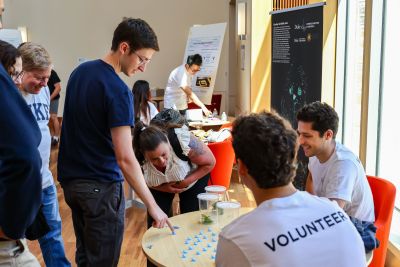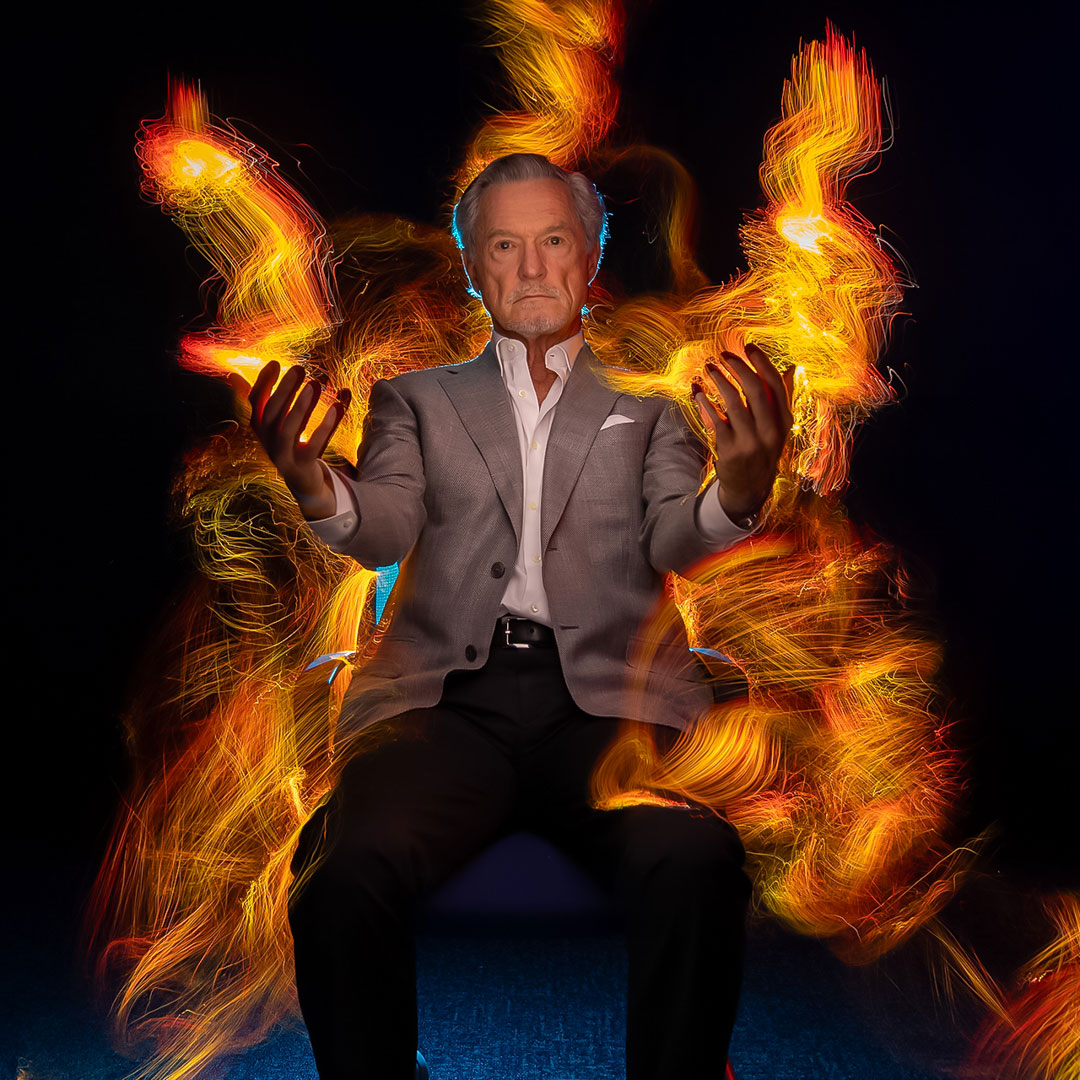Light is a storyteller, and for a young girl about to roll a giant die, it's telling an important story about treating disease.
The girl is playing a game on the third floor of the Fitzpatrick Center, home to the Fitzpatrick Institute for Photonics (FIP). As she rolls the die, the girl moves a model of a gold nanostar - a tiny synthetic particle -- through the human body to a cancerous tumor. Duke graduate student Joy Li describes how institute researchers use gold nanostars, tiny particles of gold with multiple spikes -like a star- and laser light to signal the presence of specific molecules that serve as red flags to indicate the presence of cancerous cells and potentially other diseases. Then laser light can also be used to heat the gold nanostars and kill the tumor cells that had been identified.
The big idea is that in the future the combination of light and gold nanostars will be able to identify a range of diseases in their earliest stage in a single drop of blood taken from an ostensibly healthy person, even before the individual has symptoms. Early detection of diseases is critical for maximizing treatment effectiveness, improving survival rates, and enhancing the quality of life for patients.
The work is complicated, but after 15 minutes, the girl walked away happy with a prize for getting the nanostar successfully to the tumor, and knowing a little bit about how interdisciplinary research at the FIP is using light to impact our lives.
That was the goal of the day-long symposium and open house at the institute on April 13th organized to celebrate the 100th anniversary of Duke University. More than 250 community members and alumni attended the event to hear from FIP faculty and graduate students and get a taste of the innovative ways light is being used in fields from medicine to art.
Honoring Joseph Izatt
The event also served as a moment of tribute to Joseph Izatt, chair of the Pratt School Department of Biomedical Engineering. Izatt had died earlier in the week, and one of the last things he did was to record a short video for the event describing his work with optical coherence tomography (OCT), a system that gives ophthalmologists and eye surgeons unprecedented detailed images that guide diagnosis and treatment decisions.
Professor Izatt's video was shown during the Centennial Symposium - Light in Service of Society, a series of 'Lightning Talk' videos by FIP faculty, highlighting Duke's legacy in photonics research and its societal benefits across past, present, and future. Tuan Vo-Dinh also recorded a tribute video, which played before Izatt's.
"We wanted to show the magic and power of light," said Tuan Vo-Dinh, R. Eugene and Susie E. Goodson Distinguished Professor of Biomedical Engineering, Professor of Chemistry, and director of the Fitzpatrick Institute for Photonics. "And we wanted to show how that power is being used by Duke researchers to benefit society. This work is part of the legacy of Duke, as we celebrate our centennial. We brought the community here to show what we're doing and hoping that some of the young people will see the educational value and become interested in the field."
Duke has a long tradition as a leader in research on light. One Duke alumnus, Charles Townes, went on to win the Nobel Prize for Physics for his discovery involving lasers. Over the past two decades, the institute has further elevated optical research at Duke to make the university one of the world leaders in the field.
At workstations throughout the open house, photonics graduate students described how work in the FIP's lab is advancing science to benefit society.

Among the sights was a rare glassfrog, which has the unusual ability to conceal its red blood cells in its liver while sleeping. This amazing feat protects them from predators at night but also may provide new tools for imaging technology.
At one station, biomedical engineering graduate student Márcia Cunha Dos Santos described how institute faculty are developing improved imaging to better understand how cancer behaves, creating low-cost medical tools that are transforming care for breast cancer and other diseases in low-resource communities around the world.
Dos Santos also cited the program's ethos of using creative interdisciplinary collaboration with global health scholars to develop tools that are available to many.
"The program is working to bring affordable technology to communities with little resources," she said. "In doing so, people have improved access to better health care. Some of these settings are challenging, so we're doing complex work that requires engineering but also other skills to work with the community so their needs are best met."
Engineering to explore the wonder of light was a common theme at the various stations. At a table on light polarization, graduate student Robert Trout shared his path to studying intraocular surgical imagery, which provides surgeons with real-time images of eye surgery.
"The doctors tell us they need to be able to see something, and it's up to us to engineer a way to let them do that," Trout said. "We are engineering to close a gap. A common theme here at the institute is we are all interested in finding applications that are useful and benefit society."
Finally, an unusual session was held, featuring demonstrations of light painting suitable for all ages. These demonstrations showcased the artistic use of light and culminated in an impressive laser show.
One of the visitors was Michael Fitzpatrick, the Duke alumnus whose gift through the Fitzpatrick Foundation supported the establishment of the Fitzpatrick Center of Interdisciplinary Engineering and Medical Applied Sciences (FCIEMAS) where the event took place as well as the photonics institute. Since its creation two decades ago, the FIP has been the centerpiece of the university's effort to promote cross-disciplinary research involving light-based technologies at Duke.
"For me it's fun to come back and to see the progress that's been made and talk about what will be the top advances for the coming years," Fitzpatrick said. This has evolved so much under Tuan's leadership. I think what's been so great is the interdisciplinary aspect that has been very important to us from the very beginning. It just shows how important that is and how much progress can be made when you're able to get the best of the best from all different types of scholars. it's far outside of engineering. We're now working with artists; we're working with all different forms of disciplines."


"Special thanks to the light painters, Jason D. Page, Jason Rinehart, Laura DelPrato, John Shockey, Johnny Dickerson and Jess Cruger for traveling to Duke to share light through space and time with our community. Also, special thanks to the co-sponsors and over 60 volunteers (mostly FIP graduate students) that helped make this event possible. We make a great team bringing light into the world," said August Burns, Department Business Manager for FIP and Coordinator of the event.






